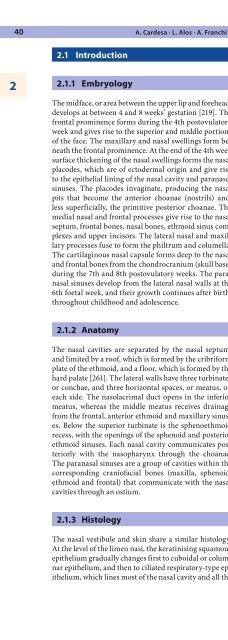Pathology of the Head and Neck
Pathology of the Head and Neck
Pathology of the Head and Neck
- No tags were found...
You also want an ePaper? Increase the reach of your titles
YUMPU automatically turns print PDFs into web optimized ePapers that Google loves.
40 A. Cardesa · L. Alos · A. Franchi22.1 Introduction2.1.1 EmbryologyThe midface, or area between <strong>the</strong> upper lip <strong>and</strong> forehead,develops at between 4 <strong>and</strong> 8 weeks’ gestation [219]. Thefrontal prominence forms during <strong>the</strong> 4th postovulatoryweek <strong>and</strong> gives rise to <strong>the</strong> superior <strong>and</strong> middle portions<strong>of</strong> <strong>the</strong> face. The maxillary <strong>and</strong> nasal swellings form beneath<strong>the</strong> frontal prominence. At <strong>the</strong> end <strong>of</strong> <strong>the</strong> 4th weeksurface thickening <strong>of</strong> <strong>the</strong> nasal swellings forms <strong>the</strong> nasalplacodes, which are <strong>of</strong> ectodermal origin <strong>and</strong> give riseto <strong>the</strong> epi<strong>the</strong>lial lining <strong>of</strong> <strong>the</strong> nasal cavity <strong>and</strong> paranasalsinuses. The placodes invaginate, producing <strong>the</strong> nasalpits that become <strong>the</strong> anterior choanae (nostrils) <strong>and</strong>,less superficially, <strong>the</strong> primitive posterior choanae. Themedial nasal <strong>and</strong> frontal processes give rise to <strong>the</strong> nasalseptum, frontal bones, nasal bones, ethmoid sinus complexes<strong>and</strong> upper incisors. The lateral nasal <strong>and</strong> maxillaryprocesses fuse to form <strong>the</strong> philtrum <strong>and</strong> columella.The cartilaginous nasal capsule forms deep to <strong>the</strong> nasal<strong>and</strong> frontal bones from <strong>the</strong> chondrocranium (skull base)during <strong>the</strong> 7th <strong>and</strong> 8th postovulatory weeks. The paranasalsinuses develop from <strong>the</strong> lateral nasal walls at <strong>the</strong>6th foetal week, <strong>and</strong> <strong>the</strong>ir growth continues after birth,throughout childhood <strong>and</strong> adolescence.2.1.2 AnatomyThe nasal cavities are separated by <strong>the</strong> nasal septum,<strong>and</strong> limited by a ro<strong>of</strong>, which is formed by <strong>the</strong> cribriformplate <strong>of</strong> <strong>the</strong> ethmoid, <strong>and</strong> a floor, which is formed by <strong>the</strong>hard palate [261]. The lateral walls have three turbinatesor conchae, <strong>and</strong> three horizontal spaces, or meatus, oneach side. The nasolacrimal duct opens in <strong>the</strong> inferiormeatus, whereas <strong>the</strong> middle meatus receives drainagefrom <strong>the</strong> frontal, anterior ethmoid <strong>and</strong> maxillary sinuses.Below <strong>the</strong> superior turbinate is <strong>the</strong> sphenoethmoidrecess, with <strong>the</strong> openings <strong>of</strong> <strong>the</strong> sphenoid <strong>and</strong> posteriorethmoid sinuses. Each nasal cavity communicates posteriorlywith <strong>the</strong> nasopharynx through <strong>the</strong> choanae.The paranasal sinuses are a group <strong>of</strong> cavities within <strong>the</strong>corresponding crani<strong>of</strong>acial bones (maxilla, sphenoid,ethmoid <strong>and</strong> frontal) that communicate with <strong>the</strong> nasalcavities through an ostium.2.1.3 HistologyThe nasal vestibule <strong>and</strong> skin share a similar histology.At <strong>the</strong> level <strong>of</strong> <strong>the</strong> limen nasi, <strong>the</strong> keratinising squamousepi<strong>the</strong>lium gradually changes first to cuboidal or columnarepi<strong>the</strong>lium, <strong>and</strong> <strong>the</strong>n to ciliated respiratory-type epi<strong>the</strong>lium,which lines most <strong>of</strong> <strong>the</strong> nasal cavity <strong>and</strong> all <strong>the</strong>paranasal sinuses, with <strong>the</strong> exception <strong>of</strong> <strong>the</strong> ro<strong>of</strong> [261].Numerous goblet cells are interspersed in <strong>the</strong> respiratory-typeepi<strong>the</strong>lium. The lamina propria contains severalseromucous gl<strong>and</strong>s, lymphocytes, monocytes, <strong>and</strong>a well-developed vascular network, particularly evidentin <strong>the</strong> inferior <strong>and</strong> middle turbinate. The olfactory epi<strong>the</strong>liumis predominantly made <strong>of</strong> columnar non-ciliatedsustentacular cells, with scattered bipolar sensoryneurons <strong>and</strong> basal cells.2.2 Acute <strong>and</strong> Chronic Rhinosinusitis2.2.1 Viral Infections (Common Cold)Infectious rhinitis is typically viral <strong>and</strong> is <strong>of</strong>ten referredto as <strong>the</strong> “common cold”. It is more common in childrenthan in adults, <strong>and</strong> <strong>the</strong> most frequently identified agentsare rhinovirus, myxovirus, coronavirus <strong>and</strong> adenovirus[67, 271]. Swelling <strong>of</strong> <strong>the</strong> mucosa may cause obstruction<strong>of</strong> a sinus ostium, with subsequent secondary bacterialinfection (acute bacterial sinusitis). The histologic findingsinclude marked oedema <strong>and</strong> a non-specific mixedinflammatory infiltrate <strong>of</strong> <strong>the</strong> lamina propria.2.2.2 Bacterial InfectionsBacterial rhinosinusitis usually follows a viral infectionor allergic rhinitis, <strong>and</strong> <strong>the</strong> most commonly involvedagents are Streptococcus pneumoniae, Haemophilusinfluenzae <strong>and</strong> Moraxella catarrhalis [11, 34]. A denseinflammatory infiltrate mainly made <strong>of</strong> neutrophils occupies<strong>the</strong> lamina propria. Acute bacterial rhinosinusitisusually resolves with antibiotic <strong>the</strong>rapy. Complicationsare rare <strong>and</strong> include contiguous infectious involvement<strong>of</strong> <strong>the</strong> orbit or central nervous system.2.2.3 Allergic RhinitisAllergic rhinitis (hay fever) is part <strong>of</strong> an inherited syndrome,which may also manifest as atopic eczema <strong>and</strong>asthma. In allergic rhinitis, airborne particles, such asgrass pollens, moulds <strong>and</strong> animal allergens, are depositedon <strong>the</strong> nasal mucosa giving rise to acute <strong>and</strong> chronicreactions. Allergens combine with <strong>the</strong> IgE antibodiesproduced by <strong>the</strong> plasma cells <strong>of</strong> <strong>the</strong> nasal mucosa,which are avidly bound to <strong>the</strong> Fc-epsilon receptors onmast cells. This triggers degranulation <strong>of</strong> mast cells <strong>and</strong>releases <strong>the</strong> inflammatory mediators <strong>of</strong> <strong>the</strong> type I hypersensitivityreaction, causing rhinorrhoea <strong>and</strong> nasal obstruction.Microscopically, <strong>the</strong> nasal mucosa shows numerouseosinophils, abundant plasma <strong>and</strong> in some casesan increased number <strong>of</strong> mast cells. There is goblet cell








